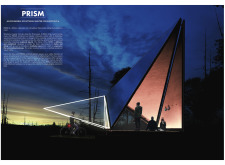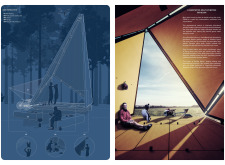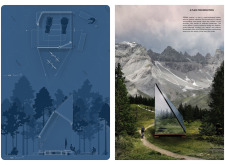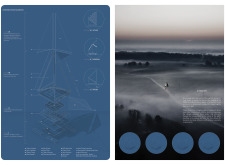5 key facts about this project
PRISM is a shelter located along the EuroVelo 6 cycling route, designed specifically for cyclists traveling this picturesque path. The structure offers protection from the weather while encouraging a connection with the natural surroundings. Its architecture combines a practical use of space with a design that integrates a calm area for contemplation, showcasing a unique form reminiscent of origami.
Design Concept
The design of PRISM highlights how light and space interact through its folded shapes. Its outer surface reflects the environment, giving it a light, fleeting quality during the day. When night falls, the structure shifts into a pyramid-like form, with bright edges that help guide cyclists looking for a place to rest. This interplay between form and function serves both the immediate needs of users and the broader environment.
Interior Layout
Inside, PRISM maintains a simple and functional layout. Storage is built into the structure, hidden beneath the main deck and accessed through removable floor panels. This keeps the space open and uncluttered. Users can hang their belongings on pegs, ensuring everything remains organized. Benches, which can be stored below the deck, provide both seating and secure storage options, balancing comfort and practicality.
Materiality
The choice of materials is carefully selected to support both strength and visual appeal. Cross-laminated lumber forms the main structure, while a reflective film enhances its interaction with light. Transparent polycarbonate panels allow daylight to enter while keeping a connection with the outside world. A steel framework provides necessary support, making the structure resilient in an outdoor environment.
Construction Methodology
Building PRISM involves a clear and logical process. It starts with creating footings designed for the specific site conditions. Next, prefabricated components are assembled, followed by erecting the steel framework. The final steps include attaching the cross-laminated lumber and the reflective surfaces. This method allows for efficient construction and quick placement along the cycling route.
The interior of PRISM features two key openings: one directed towards the cycling path and another that frames sweeping views of the natural landscape. This arrangement encourages interaction with the surroundings, enhancing the experience for cyclists who stop to rest.






















































